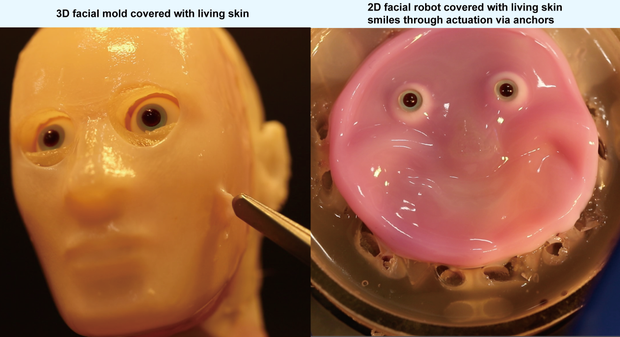Professor Shoji Takeuchi of the University of Tokyo developed the alien-like machine utilizing engineered pores and skin hooked up to a humanoid robotic.
Takeuchi beforehand created strolling mini robots utilizing 3D-printed lab-grown meat, engineered pores and skin and organic muscle tissue. He determined to continue to develop the skin characteristic, which was grown within the Biohybrid Systems Laboratory on the college.
©2024 Takeuchi et al.
“During earlier analysis on a finger-shaped robotic coated in engineered pores and skin tissue we grew in our lab, I felt the necessity for higher adhesion between the robotic options and the subcutaneous construction of the pores and skin,” Takeuchi said in a news release. “By mimicking human skin-ligament constructions and through the use of specifically made V-shaped perforations in strong supplies, we discovered a strategy to bind pores and skin to advanced constructions.”
He stated the pure flexibility of the pores and skin and its sturdy adhesion to the robotic make it in order that the pores and skin can transfer with out peeling or tearing. The researchers used collagen for adhesion and plasma remedy to maneuver the collage into the perforations of the robots’ mechanics. With this technique, the pores and skin could be added to any floor.
But, he stated, this technique is way more durable than individuals would possibly assume as a result of micro organism can enter the pores and skin and the tissue can die.
Unlike chemical-based supplies used to make pores and skin, the dwelling pores and skin can self-heal, which Takeuchi stated was a giant deal.
©2024 Takeuchi et al.
The pink blob was simply the 2D mannequin of the dwelling pores and skin robotic. The researchers additionally made a 3D mannequin with a extra human-like head form. Takeuchi stated the subsequent problem is making the pores and skin thicker and including options like wrinkles to make it extra human-like.
“We imagine that making a thicker and extra real looking pores and skin could be achieved by incorporating sweat glands, sebaceous glands, pores, blood vessels, fats and nerves,” he stated within the information launch. “Of course, motion can also be a vital issue, not simply the fabric, so one other vital problem is creating humanlike expressions by integrating subtle actuators, or muscular tissues, contained in the robotic.”
“Creating robots that may heal themselves, sense their atmosphere extra precisely and carry out duties with humanlike dexterity is extremely motivating,” he stated.
So, what would possibly these human-like dwelling pores and skin robots be used for? Takeuchi says these robots can be utilized in medical analysis like drug improvement and may also be utilized in pores and skin growing older, cosmetics analysis and plastic surgeon coaching.










































